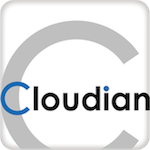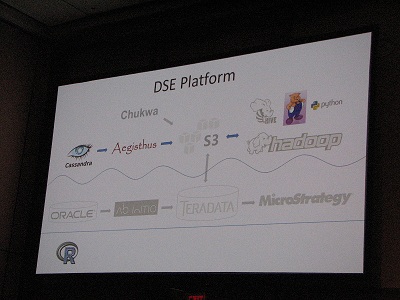 “Big Data and Cloud Storage” Vol. 4
“Big Data and Cloud Storage” Vol. 4
Event and Company #2
Cloud Expo Europe and Citrix
In London, “Cloud Expo Europe” took place on January 29th and 30th, 2013. Cloudian exhibited at the Expo, so I asked Giorgio Propersi, General Manager, Americas and EMEA at Cloudian, how the Expo and the cloud industry look like in London.

◆ “Cloud” as an international phenomenon
I attended another “Cloud Expo” in Santa Clara last fall. In that conference, I felt that the main focus was on OpenStack – an open source software for IaaS (Infrastructure as a Service) – and was wondering if it was the same in London, but Giorgio has a different impression.
Giorgio: Both in Santa Clara and in London, I think the shows were neutral, rather than focused on OpenStack. Surely, OpenStack foundation and other big OpenStack supporters such as Rackspace were big sponsors, but there were also many companies supporting other types of cloud such as CloudStack.
What amazed me was how much the (London) show grew bigger than last year. 2012 was much smaller and it was more “hosting” focused. This year, finally the show was really “cloud” centered, and companies were showing cloud computing or cloud storage technology, and all technologies around the cloud (such as how to manage the cloud, keep track of what is happening in the cloud, debug the cloud and so on). The floor was very full. The show organizer was expecting 5000 attendants, but I thought there were much more people.
Once inside the venue, many US companies were exhibiting, (NTT was also there), and it was really hard to see the difference from an U.S. - based show. It was indeed a very international show. There were some European companies but these Companies were at the Santa Clara show too. I think the balance was the same as in the U.S. Customer profile was also not much different, just geographically different, with more representation from companies centered in Europe and Asia (such as BT and Tata Communications). There was also a nice representation of small European service providers from many countries in Europe.
◆ CloudStack and Citrix
CloudStack is another open-source IaaS software. CloudStack was developed by Cloud.com, which was acquired by Citrix in 2011. Both Cloud.com and Citrix were OpenStack members, but after the acquisition, Citrix released CloudStack in 2012 and donated it to Apache Software Foundation, then decided to leave OpenStack group. A bit complicated, but anyway CloudStack is now a separate project from OpenStack. Joe Onisick writes in his article in Network Computing that CloudStack is better packaged for enterprise adoption, while OpenStack is more like framework and has strong supporters.
Giorgio: We need to keep in mind that Cloudian integrates with both OpenStack and CloudStack. It is hard to simplify the differences between them, and customers may choose one or the other for completely different reasons. There are plenty of technical papers describing the differences between the two open source approaches, and the merits/demerits of each one.
Quite often, if I am an enterprise or a service provider and am moving my system to the cloud, I would look for a solution that is proven, and fully supported by my technology supplier. If I get the open source code directly, I will need to commit a lot of my internal engineering resources; and later on I will be responsible to support my cloud. This may not be good for many companies. Assuming for example I am a bank, I would rather spend my time and money in doing what I do best, such as banking, so I would rather go talk to my trusted technology supplier, who will take care of my cloud. I buy the cloud from my technology provider not because of which open source software they use inside, but because the cloud solution they will be proposing to me works for me, and is optimized with my existing system and the price is right. In some cases, customers don’t even know what technology their cloud is based on.
And open source is not the only cloud technology. Microsoft, VMware and others have their own cloud solutions.
Citrix provides Cloud Platform, their commercial version based on CloudStack, and this the cloud platform people buy from Citrix today.
◆ STaaS and Secondary Storage
Citrix’ Cloud Platform is such a solution for enterprise customers, but they don’t have the object storage piece, so they integrate with Cloudian.
Giorgio: Citrix can provide two additional functionalities by integrating Cloudian (the object storage infrastructure provided by Cloudian, Inc.) to their Cloud Platform, functionalities which they don’t have at this moment. One is STaaS (Storage as a Service) based on S3. STaaS means the capability of storing objects in the cloud, and use the cloud as storage. And the S3 compatibility allows the concept of the hybrid cloud. Many companies have adopted the concept of hybrid cloud. For example, I want to store specific files in the public cloud (such as Amazon), and specific files to my private cloud; and I keep changing my mind with regard to the destination of my data. The only way to handle this situation (that I want “some” data in the private cloud, and “some” data in the public cloud) is to have the same interface to the public and to the private cloud. So I can easily switch between the two. This interface is S3, which is fully supported by Cloudian. So the STaaS functionality with S3 compatibility is very beneficial; and this is what Cloudian adds to Cloud Platform.
The other functionality has to do with the way Secondary Storage is stored. While primary storage is the immediate disc for items that need to be accessed very quickly and used directly by the application (such as an excel spreadsheet), Secondary storage is used for snapshots, templates, ISOs, VMs, etc. If you use Cloudian to store Secondary Storage, then Secondary Storage becomes available to every zone within a CloudStack cloud. In non-Cloudian environment, typically secondary storage is stored in the local NAS, and because of that it can only be accessed locally; and if that zone is down, these templates, VMs, snapshots, etc. are not available – which is bad. This functionality is very important. Visitors to our booth at Expo really liked this, since maintaining visibility to all critical Secondary Storage from every zone is of paramount importance.
◆ “Object storage”, rather than big data or cloud
I have been writing this column on the theme of “big data and cloud storage,” but Giorgio prefers to describe what we are dealing with here as “object storage”, rather than “big data” or “cloud storage.”
Giorgio: We prefer to refer our product as the latest and greatest object storage technology (rather than big data).
The term “big data” can be misleading, because the size really is not always the motivation for object storage. Many companies start using object storage in a small way, such as with 5 or 10 terabyte, but they store data in object storage in the cloud (instead than using most traditional storage technology) because of the a. cost, b. efficiency and c. scalability, so they can scale to big data later on. People like object storage because of its simplicity, its affordability and its scalability.
And object storage fits so well to the cloud. Cloud is important because I don’t have to buy my storage anymore, or I don’t have to hire people to manage it either. I can outsource my storage to the cloud.
◆ Cloudian for Citrix
So what is important for customers in choosing object storage?
Giorgio: Compared to other object storage partners of Citrix, Cloudian’s strengths are the full S3 compatibility, and the ability to support multiple datacenters. Multi-datacenter support is not easy. When our first European customer Lunacloud wanted to add a second datacenter in France (on top of the existing datacenter in Portugal), it was a big factor. We support several configurations with regard to how many replicas can be kept, and where these replicas are kept. Other companies cannot do that. And keep in mind that Cloudian was Citrix only storage partner at the Citrix booth in London.
At London Expo, we announced Cloud Portal Business Manager (CPBM) with Citrix as well. It is a dashboard to manage cloud services on the web, so now a customer – using the CPBM, can add (or modify) a cloud storage service, that is provided by Cloudian through this portal.
 “Big Data and Cloud Storage” series Vol. 5: Event and Company #3
“Big Data and Cloud Storage” series Vol. 5: Event and Company #3



